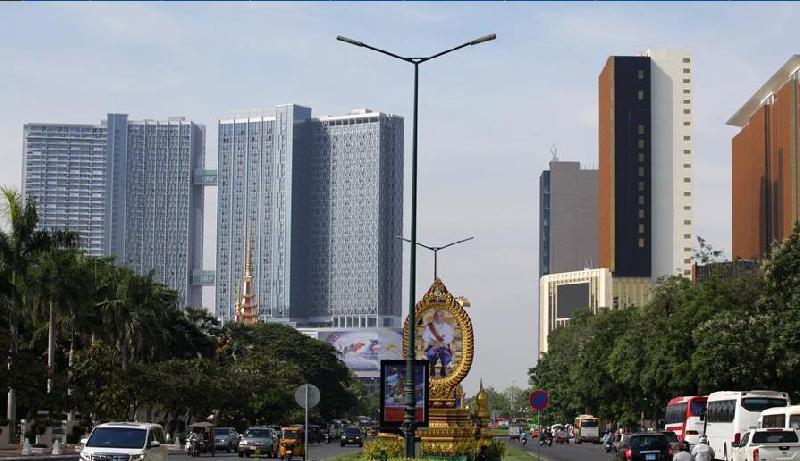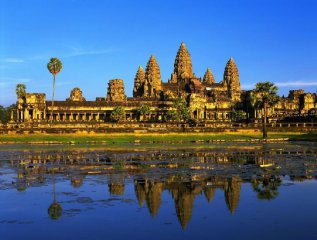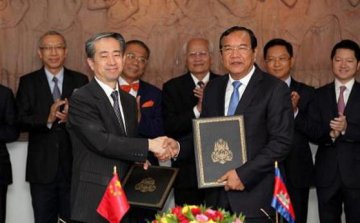
Photo taken on May 24, 2018, shows high-rise buildings in Phnom Penh, Cambodia. Cambodia has seen rapid development in transport infrastructure, energy, trade, investment, construction and real estate, and tourism in the last five years, officials and experts said. TO GO WITH Spotlight: Cambodia sees remarkable progress in socio-economic development in last 5 years.
Cambodia has seen rapid development in transport infrastructure, energy, trade, investment, construction and real estate, and tourism in the last five years, officials and experts said.
Chan Sophal, director of the Center for Policy Studies, said he had observed that the government had worked actively to develop these sectors in its fifth term (2013-2018), which had greatly contributed to socio-economic development and poverty reduction.
"As we all have seen with our own eyes, there has been remarkable development of infrastructure such as roads, bridges, railroads, and hydropower plants in the past five years," he told Xinhua. "For construction, high-rise buildings, office buildings, and condos have been developed rapidly these years."
UPGRADED TRANSPORT INFRASTRUCTURE & ENERGY
Va Simsorya, a spokesman for the Ministry of Public Works and Transport, said several large bridges across the Mekong River, about 1,500 km of national roads, ports, and railroads had been built in the fifth five-year term of the government.
He said the Southeast Asian nation had invested an average of 300 million U.S. dollars a year for the development of transport infrastructure.
"We have made a lot of achievements in transport infrastructure in the last five years, and China is the largest aid provider to Cambodia for infrastructure development such as roads, bridges and ports," he told Xinhua. "China's assistance is vital to boost Cambodia's economy and to reduce poverty."
"With good transport infrastructure, more and more foreign investors and tourists have been coming to Cambodia," he said. "Currently, roads from Phnom Penh to various provinces have been paved with tar and people are easy to travel to and fro."
Simsorya said besides internal connectivity, Cambodia is also well connected with its neighboring countries -- Thailand, Vietnam and Laos -- by land.
He said transport infrastructure development would be still the priority for Cambodia in the coming years, saying that the ministry would further increase its investment in the sector to meet the growth of economy, trade, and population.
"We need to invest more in this sector because we want big airports, big ports, good railways, and expressways," he said.
On the energy sector, the kingdom has seven hydropower plants that can produce a total of 1,328 megawatts of electricity, accounting for 58 percent of the electricity demand last year.
All of the projects were invested by China, and four of them with a combined capacity of 1,002 megawatts had come online between 2013 and 2017.
Also, the country has two coal-fired power plants with a total capacity of 500 megawatts.
Minister of Mines and Energy Suy Sem said energy had importantly contributed to the socio-economic development, saying that 83 percent of the country's 14,139 villages had access to electricity by the end of 2017, up from 51 percent five years ago.
"These historic achievements have existed thanks to the hard-earned peace that Prime Minister Samdech Techo Hun Sen has brought to the nation and people of Cambodia," he said during the inauguration ceremony of a cement plant in Battambang province on Thursday, May 31.
EXPANDING TRADE AND INVESTMENT
Export increased by 62 percent to 11.2 billion U.S. dollars in 2017 from 6.9 billion dollars in 2013, while foreign direct investment rose by 40 percent to 6.3 billion dollars last year from 4.48 billion dollars five years ago, according to government figures.
Commerce Ministry Secretary of State Mao Thora attributed the increases to the government's efforts in expanding overseas markets for Cambodian products and to investors' confidence in the country's business atmosphere, law, peace and political stability.
"The development of infrastructure such as roads, bridges, ports, electricity, and special economic zones has also contributed to increasing our export volume," he told Xinhua.
"With peace and political stability along with attractive law, I believe that economy, trade and investment will continue to grow in the coming years," he said.
Thora said Cambodia saw China as the biggest market for its products in the future.
BOOMING CONSTRUCTION, REAL ESTATE & TOURISM
Cambodia attracted construction projects worth 6.4 billion U.S. dollars in 2017, up 131 percent from 2.77 billion dollars in 2013, according to the Ministry of Land Management, Urban Planning and Construction.
"High-rise buildings, new towns and residential complexes have mushroomed in the past five years," Seng Loth, a spokesman for the Ministry of Land Management, Urban Planning, and Construction, told Xinhua.
The kingdom currently has nearly 1,000 high-rise buildings (between five and 54 floors), up from just a few hundred five years ago, he said, adding that the country now has nearly 200 new towns and residential complexes.
"Most of the high-rise buildings and new towns are located in Phnom Penh," he said.
The spokesman attributed the boom in the construction and real estate to peace, political stability, favorable law and incentive policy for investors, and sound macro-economic stability.
"Investors dare to invest billions of U.S. dollars in the sector because they are confident in these factors," said Seng Loth. "China is the largest investor in construction and real estate here, followed by South Korea and Japan."
Cheng Kheng, chairman of board of directors of the Cambodian Valuers and Estate Agents Association, said Chinese contractors constructed high-rise buildings fast with advanced technologies and quality.
For tourism, Cambodia received 5.6 million international tourists in 2017, a 33-percent rise from 4.2 million in 2013. The gross revenue from the sector grew by 38 percent to 3.6 billion U.S. dollars last year from 2.6 billion dollars five years ago.
Tourism Minister Thong Khon said tourism accounted for 13 percent of the kingdom's GDP last year, and created more than 620,000 direct jobs.
"It's expected that Cambodia will get 6.2 million foreign tourists in 2018 and over 7 million by 2020, bringing in total revenue of 5 billion U.S. dollars and generating one million jobs," he said.
FUTURE DEVELOPMENT PRIOR
Mey Kalyan, chairman of the Cambodia Development Resource Institute, said overall, the development over the last five years was positive with an average growth rate of 7 percent annually. There would be a number of remaining tasks that needed to be done in the next 5 years, he added.
From 2013 to 2017, economy grew by around 7 percent a year, pushing up the GDP volume from 15.2 billion U.S. dollars to 22 billion dollars, according to government figures.
Poverty rate had fallen from 19 percent in 2013 to 12 percent last year.
Kalyan said for the priority sectors in the next five years, the government should emphasize on concrete implementation of reforms and quality of growth.
"To do this, I believe we need to focus on governance, human resources development, science and technology, and diversify our economy and upgrade our economy to a higher value-added economy," he said.
"On social aspect, we need to pay more attention to social justice because it is very natural in many countries. When a country makes some progress economically, inequality will emerge, and thus there will be more demand on social justice from emerging middle class," he said.
"And also we need to take care of our environment so that our future generations will not blame us," said Kalyan, who is also a senior advisor to the Supreme National Economic Council.
























Latest comments